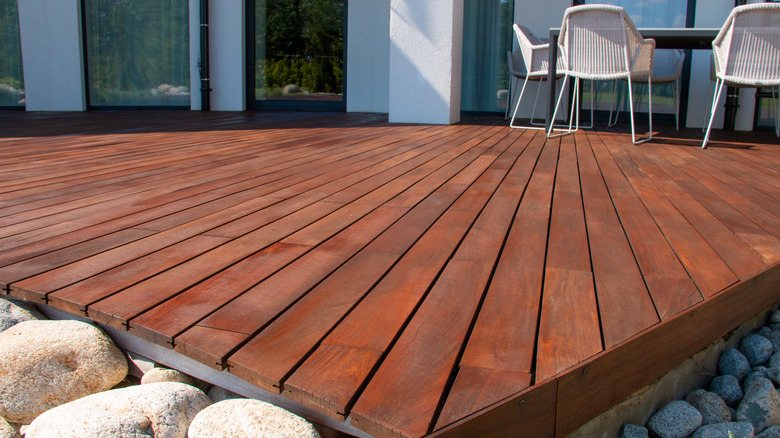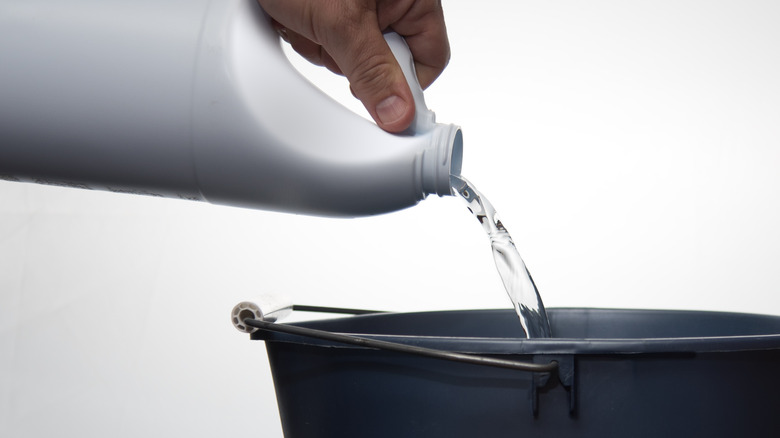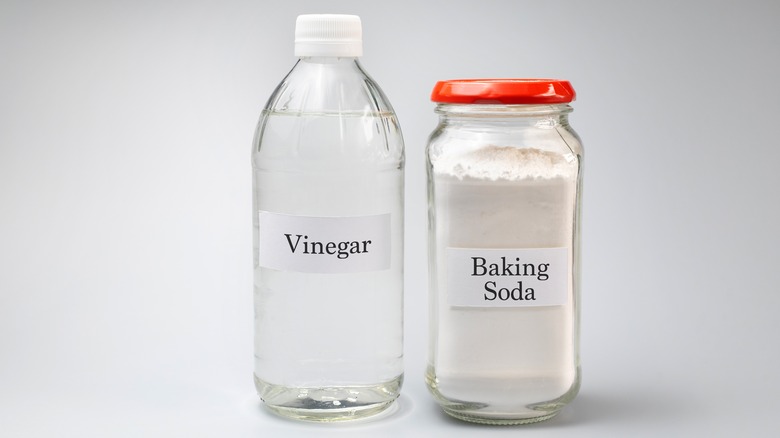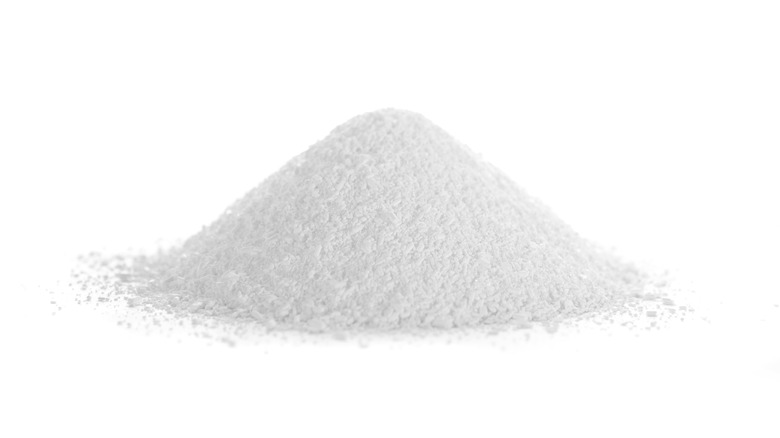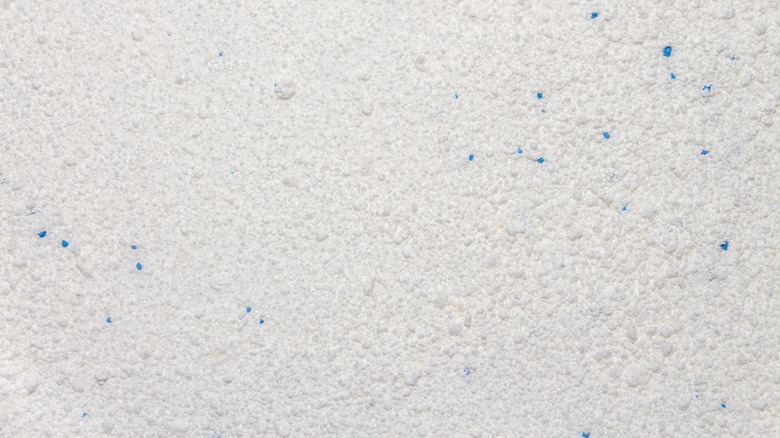4 Homemade Cleaners That Will Keep Your Deck Looking Brand New
Unless you want it to be overrun by mold, mildew, sap, pollen, and algae, your wooden deck is going to require yearly maintenance, according to WIN Home Inspection. There will also be stains, moss, and all-around dirt to contend with on a regular basis. Fortunately, a wide selection of effective homemade cleaners is at your disposal, including several eco-friendly and economical options.
Of course, always don protection when applying any cleaners to your deck — whether homemade or commercially obtained. That means eyewear, a mask, coveralls, gloves, and even protective footwear. Using a brush attached to a pole to minimize inhaling vapors from the cleaning substances is advisable; it will also save wear and tear on your back and knees. Homemade deck cleaners are easy to create, but it's important to test your potions on an inconspicuous, less visible area before slathering them on.
Composite decks are easier to clean than decks made of wood, but paradoxically, they cannot withstand some of the harsher cleansers acceptable for wood, per Plasticine House. Think "mild" when planning composite deck maintenance. Cleaning your deck on a cloudy day makes sense to prevent the DIY solutions from prematurely drying up. Trex Protect offers this additional practical piece of advice: Be wary of using homemade cleaners in a pressure washer to avoid the possibility of clogging the nozzle. That said, here are four homemade cleaners that are good for your deck and easy on the pocketbook.
Oxygen bleach, dish soap, and borax
Lather created by mixing a few squirts of ammonia-free dish soap, 2 cups of oxygen bleach (instead of commercial strength chlorine bleach), and 2 gallons of warm water does wonders to lift oily stains and remove persistent dirt and grime. Per Texas Capital, oxygen bleach combines soda ash and hydrogen peroxide to effectively eliminate deck stains. Chlorine, though, is capable of damaging a deck made from composite materials and should be used cautiously, if at all. Unlike its chlorine-based counterpart, oxygen bleach will neither degrade the lignin binder in wood nor weaken the color of it. Oxygen bleach is also recommended by My Chemical-Free House to counteract the graying appearance of wood.
In addition, borax can be used along with the dish soap and bleach to suppress mold, mildew, and fungus. It also has the added benefit of being harmless to plants. Rubbing alcohol works well to deter mold too. Sweeping your deck daily and cleaning the gaps between the deck boards are worthwhile mold-prevention strategies to go along with scrubbing the surface with bleach, dish soap, water, and a touch of borax.
Baking soda, vinegar, dish soap, and water
White or apple cider vinegar is appropriate to apply to composite decks. A cup of vinegar and 2 tablespoons of dish soap in a bucket of warm water should suffice as a homemade deck cleaner, according to Dang Good, which recommends letting the solution sit on the deck for 10 minutes before rinsing it off. Vinegar is also suitable to use as part of a regular light-cleaning regimen for composite surfaces. Acetic acid is a bacteria and mold killer, and you can use baking soda (sodium bicarbonate) along with it as an effective deodorizer to refresh the deck from the vinegary aroma. For added cleaning strength, baking soda can be sprinkled directly on stubborn stains before brushing on the vinegar, soap, and water solution. The sodium bicarbonate is said to work especially well on pesky BBQ stains. For best results, Gardening etc recommends leaving it on for a few hours, then hosing it off.
When it comes to wooden decks, WOCA Wood Care warns against letting vinegar sit for more than an hour on wood. Left longer than that, it may begin to draw color out of the wood. Also, do not use undiluted vinegar on wood. Take pains as well to keep the vinegar away from the surrounding soil and plants, unless you plan on using the mixture as a weed-killer.
Trisodium phosphate (TSP) and powdered household bleach
Trisodium phosphate (TSP) is a heavy-duty algae killer and mildew remover, powerful enough to clean concrete, but safe to use on a treated wood deck. Per Home Smiles, this inorganic chemical compound reacts with water to create an alkaline solution with strong cleaning, degreasing, and stain-removing power. It is also effective for remedying flaky or peeling areas of a deck. Log Home Living suggests formulating a diluted solution consisting of 1 cup of trisodium phosphate, 1 cup of oxygen bleach, and 2 gallons of warm water. After first prepping the deck by soaking it with plain water, scrub on the mixture. Keep it on the deck for 15 minutes or so, then rinse thoroughly. In all cases, allow the deck to air dry.
Deck Master warns that TSP may discolor a mahogany deck or cause grout to crumble. It can also harm foliage, so soak nearby plants with water before using it, and rinse them off after the deck has been cleaned. Note that the sale of TSP is restricted in some areas and jurisdictions. Another homemade mildew remedy relies on an ammonia-free detergent in place of the oxygen bleach, and older recipes call for rubbing alcohol as an additional ingredient.
Powdered laundry detergent
In addition to cleaning your clothes, powdered laundry detergent can be used to clean a deck. If the wood looks wan from the ravages of winter, make it shine again using laundry cleaner. The powder serves both as a cleanser and an abrasive. It is a potent grease fighter, and a much less harsh option to bleach or TSP. Mix with a gallon of warm water or spread it dry on top of grease stains and then scrub with a wet brush. As an improvised alternative, Gardenerdy suggests mixing a tablespoon of oxalic acid crystals into the detergent and water solution to fight the blemishes.
The Money Pit provides the recipe for this do-it-yourself deck cleaner. In a 5-gallon bucket, combine 3 quarts of warm water with a quart of bleach and a ½ cup of the powdered laundry detergent. A word of warning: Make sure to avoid a potentially toxic combination of incompatible ingredients by being especially careful with ammonia. Mixing bleach with detergent containing sodium percarbonate (SPC) or sodium perborate (PBS) is safe, however. Brush it on and let the solution seep into the deck for several minutes, then rinse thoroughly. As is the case with TSP, take steps to protect adjacent grass and foliage.
